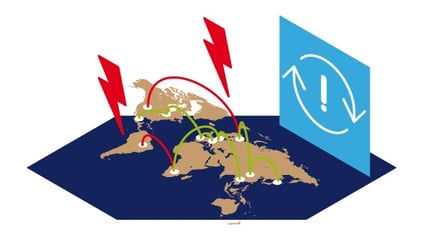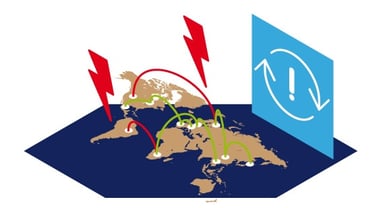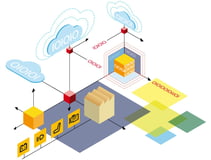How (the Right) Supply Chain Software Can Reduce Waste
Brian Hoey - January 28, 2020

 It’s a popularly quoted statistic that supply chain inefficiencies can waste as much as 25% of operating costs, which only goes to show how much an impact you can have on your bottom line by working to reduce waste. This is, of course, easier said than done: supply chain waste comes in myriad forms and is notoriously difficult to root out. Why? Because every decision you make across the entire value stream has the potential to introduce unforeseen costs down the road.
It’s a popularly quoted statistic that supply chain inefficiencies can waste as much as 25% of operating costs, which only goes to show how much an impact you can have on your bottom line by working to reduce waste. This is, of course, easier said than done: supply chain waste comes in myriad forms and is notoriously difficult to root out. Why? Because every decision you make across the entire value stream has the potential to introduce unforeseen costs down the road.
If, for instance, you store a production run of fast-moving products in the back of your warehouse, the time and resources it takes to move them from where they’re stored to where they’re going to be loaded into trucks could count as waste. Likewise, any delay between one production run and the other can decrease your throughput and make it impossible to operate at your theoretical maximum production capacity. Even if your warehouse isn’t arranged to optimize the use of space (which can be more difficult with larger or more irregularly shaped products), you run the risk of paying for square-footage that you don’t really need.
No supply chain, no matter how lean, operates with 100% efficiency—but as we approach the Industry 4.0 era, there are more tools than ever before at the disposal of your average supply chain manager. Today, we’ll look at how digital transformation in the supply chain is making waste reduction more feasible than ever.
Principals of Supply Chain Waste Management
Above, we hinted at some of the biggest causes of waste in the modern supply chain, which fall into a few broad categories:
- Mismanagement of space
- Mismanagement of time
- Supply chain errors/events
Each category contains some big potential areas of inefficiency. Mismanaged space could mean using your warehouse in a way that’s not cost effective or that doesn’t integrate well with your transportation logistics. Mismanaged time could mean production delays, long lead times, gaps in your production schedule, etc. And errors are just what they sound like—any honest mistakes that cause a product to be shipped to the wrong place, stored in the wrong location, or produced incorrectly.
Again, disruptions of this kind are going to happen in even the most sophisticated supply chain. The question is, how can you minimize them? On some level, the key here is to actually be able to identify areas of waste, ideally before they arise. This means you need not just visibility into what is actually happening at each touchpoint on the value chain, but also the discernment and analytical prowess to identify a process or action that isn’t as efficient as it could be. In some cases, this can be pretty easy. If, for instance, you’re comparing your expected production capacity to your actual throughput and finding a greater discrepancy than you would like, you can drill down on the nitty-gritty production details to figure out what’s going wrong. With something like space-optimization for a transport network, on the other hand, it’s often hard to uncover any potential issues merely by eye. This is where supply chain management software solutions come in.
How Digital Transformation Fights Inefficiency
Since it can be difficult or impossible to figure out the optimal route for a truck to take over the course of several different deliveries and backhauls (to choose just one example) just by mapping it out with pen and paper, digital processes are often the only way to uncover inefficiencies in your supply chain and optimize the relevant processes. Where a human planner can take in and analyze only a certain number of data points, a smart SCM solution equipped with advanced prescriptive analytics can analyze huge caches of data in order to produce actionable insights for planners. This might take the form of feeding historical transport routing data to a machine learning algorithm so that it can pinpoint potential areas where efficiency could be improved—or it might look like real-time production data being analyzed by a program designed to predict machine breakdowns and schedule proactive maintenance.
In both of the examples we listed above, the biggest potential stumbling block is collecting and storing the relevant data in the first place. This is why it’s not enough for a given manufacturing outfit to adopt a solution that boasts these predictive and prescriptive analytics capabilities—rather, businesses need to integrate their technology in such a way as to ensure that the programs that need access to large caches of data actually have that access. This means not just changing out your S&OP software for something that looks shinier and more sophisticated, but carefully considering whether that new S&OP solution will make it easy to keep up-to-date capacity data in a central location where it’s accessible to both human planners and smart, digital processes.
Choosing the Right Supply Chain Software Solution
As you can imagine based on the preceding, the right supply chain software solution can help you reduce waste significantly—while the wrong solution will just lead to more headaches. How do you figure out whether you’re looking at the right solution? Great question! For starters, there are a few things you should ask yourself:
- How easily will this software integrate into my existing IT environment?
- What data sources can I connect to it?
- How flexible and adaptable is the solution to changing technological and market realities?
- Does it promote open communication, or will it lead to silos and shadow IT?
- Will it help promote collaboration across functions?
These first few questions should give you a sense of how effectively the technology will position you not just for active monitoring and analysis, but leveraging that analysis into operational improvements. We’ve cited plenty of causes of waste in the supply chain up to this point, but at the heart of most areas of waste and inefficiency you’re likely to find data and decision-making silos that prevent smooth functionality. At a bare minimum, any piece of technology you consider should be designed to reduce and remove silos. From there, you’ll need to consider how well the features align with your specific business needs, alongside the different ways that it will or won’t improve connectivity, transparency, and visibility.
LATEST POSTS
- Understand Why Production Planning Needs Specialized Solutions
- Understand Circular Economy in The Manufacturing Industry
- How Can Industry 4.0 IT Integration Be Achieved Smoothly?
- The Significance of Order Sequencing in Discrete Manufacturing
- How to improve your Supply Chain Management: The Power of Control Towers



